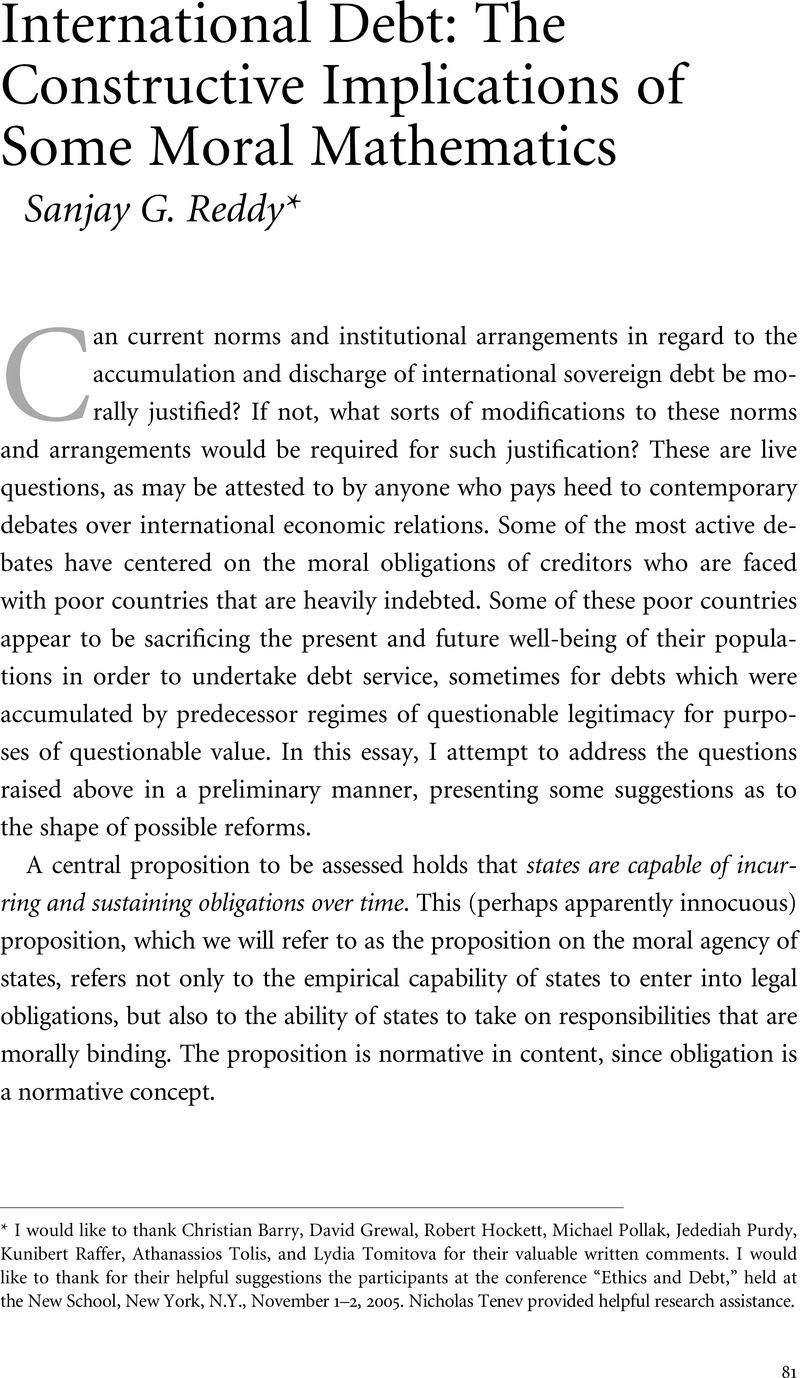Published online by Cambridge University Press: 25 March 2011

1 I do not comment on the question of how these intertemporal threads should be conceived, for example, in terms of invariance of personal identity or of psychological connectedness and continuity (on which see Derek Parfit, Reasons and Persons [Oxford: Oxford University Press, 1984]).
2 I make the conventional distinction between deontological (i.e., process-related) and consequentialist (i.e., outcome-related) moral considerations for purposes of convenience. In doing so, I do not take a view on whether moral considerations conventionally viewed as deontological can in fact be viewed in terms of consequential evaluation within a framework that is adequately rich (as argued, for instance, in Amartya Sen, “Consequential Efficacy and Practical Reason, ” Journal of Philosophy 97, no. 9 [2000]).
3 Whether a specific instance of derogation from the formal provisions of a contract should be viewed as an “exemption” (as contrasted with an implicit clause of the contract) may depend on the extent to which it is part of the common background understanding of the contracting parties. For instance, the possibility that a domestic debt contract may be made subject to the provisions of bankruptcy law may be thought to be part of the common background understanding of the contracting parties, and thus to constitute an implicit provision of the contract rather than an exemption.
4 The determination of whether the freedom of choice is present may depend on diverse considerations, including the availability of distinct alternatives, the ability to choose for oneself among the distinct alternatives, and the nature of the alternatives themselves. See the distinction between the freedom to choose and choosing freely in G. A. Cohen, “Why Do Workers Choose Hazardous Jobs?” in History, Labour, and Freedom: Themes from Marx (Oxford: Oxford University Press, 1989); and the discussion of procedural and substantive freedom in the context of international agreements contained in Christian Barry and Sanjay Reddy, International Trade and Labor Standards: A Proposal for Linkage (New York: Columbia University Press, forthcoming).
5 There is an extensive literature addressing pertinent issues under the name of the “nonidentity problem.” See, in particular, Parfit, Reasons and Persons.
6 It has been proposed that there are such instances, e.g., when the individuals to whom obligations are being attached participate in a shared framework of collective decision-making that meets particular tests (such as implicit or explicit consent to the decision-making structure itself) or when they are beneficiaries of an action taken by others. See, e.g., David Miller, “Holding Nations Responsible, ” Ethics 114, no. 1 (2004), pp. 240–68. It is important to note that such attribution requires, at the least, special preconditions.
7 The inefficiency arises from the fact that lower borrowing combined with appropriate transfers of income between persons could in principle bring about a Pareto improvement.
8 See Andreu Mas-Colell, Michael D. Whinston, and Jerry R. Green, Microeconomic Theory (Oxford: Oxford University Press, 1995), ch. 19 (“General Equilibrium Under Uncertainty”), and the broader literature on Arrow-Debreu securities and related concepts.
9 I employ the term “welfarist” to refer to a focus on subjective preference satisfactions as the sole informational basis for evaluation.
10 See Robert J. Shiller, Macro Markets: Creating Institutions for Managing Society's Largest Economic Risks (Oxford: Oxford University Press, 1993); and Robert J. Shiller, The New Financial Order: Risk in the 21st Century (Princeton: Princeton University Press, 2003). See also Sanjay Reddy, “Safety Nets for the Poor: A Missing International Dimension?” in Giovanni Andrea Cornia, ed., Pro-Poor Macroeconomics: Potential and Limitations (New York: Palgrave Macmillan, 2006).
11 See Harold James, International Monetary Cooperation Since Bretton Woods (Oxford: Oxford University Press, 1996), on the debt crisis. More generally on the early 1980s as a period of high world real interest rates, see Menzie Chinn and Jeffrey Frankel, “The Euro Area and World Interest Rates, ” Santa Cruz Center for International Economics Working Paper Series 1016 (Center for International Economics, University of California at Santa Cruz, November 2003); available at ideas.repec.org/p/cdl/scciec/1016.html; and Jong Eun Lee, “On the Characterisation of the World Real Interest Rate, ” World Economy 25, no. 2 (2002), pp. 247–55.
12 Kunibert Raffer (in this volume, pp. 127–50) has argued for the recognition of principles in international law that provide for the legitimate interests of creditors to be balanced against such basic interests of populations during debt workouts.
13 Thomas Pogge, World Poverty and Human Rights (Cambridge: Polity Press, 2002); and Seema Jayachandran and Michael Kremer, “Odious Debt, ” American Economic Review (forthcoming).
14 See also the discussion in the works by Shiller, n. 10.
15 It should not be necessary to underline that in providing the example of the IMF's Policy Signaling Instrument I am not suggesting either that it is in itself attractive or that the IMF would be the appropriate agency to do such monitoring more generally. For a description of the Policy Signaling Instrument, see International Monetary Fund, “The Policy Support Instrument: A Factsheet” (August 2006); available at http:\\www.imf.org/external/np/exr/facts/psi.htm.
16 See National Research Council, Monitoring International Labor Standards: Techniques and Sources of Information (Washington, D.C.: National Academy of Sciences, 2004), esp. ch. 3, “Information from Nongovernmental Labor Monitoring Systems.”